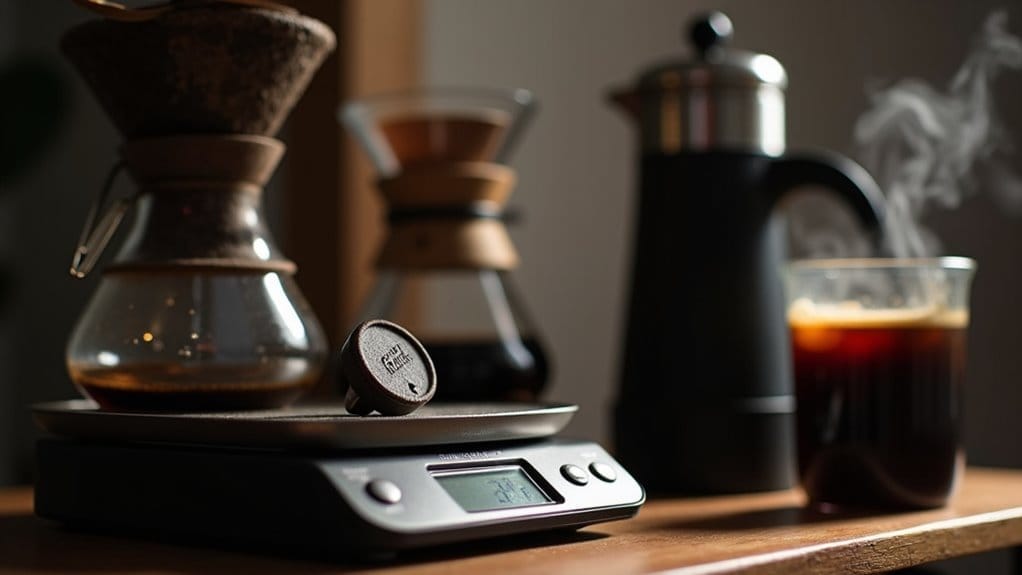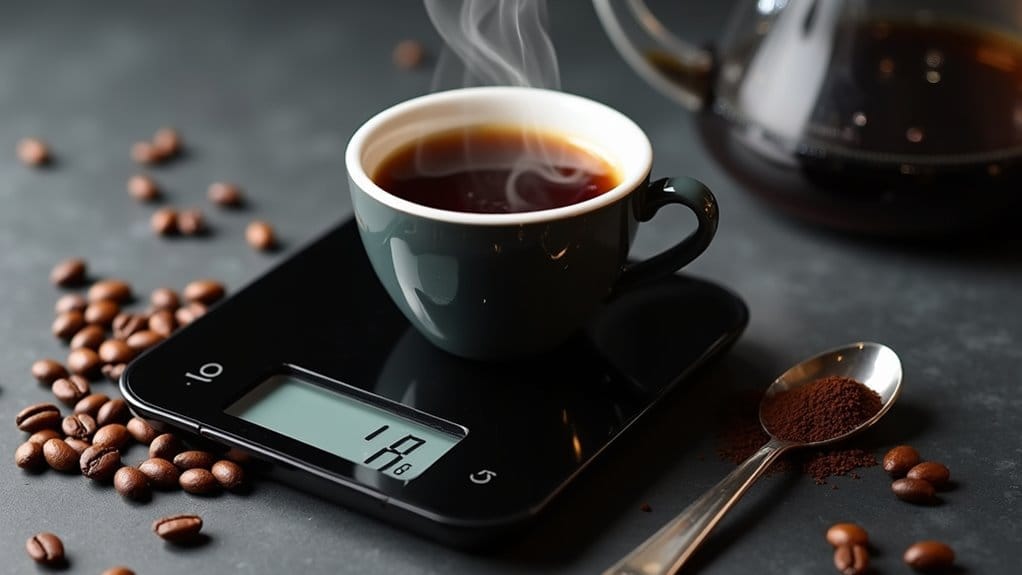The Real Caffeine Numbers in Your Coffee Cup
Every sip of coffee hides a caffeine surprise! How much caffeine in one cup of coffee isn’t one number, it’s a roller coaster!
Home drip averages 95 mg to 165 mg, while espresso packs more punch per ounce yet arrives in tiny shots, so the average caffeine in a cup of coffee depends on mug size. Brew methods can increase or decrease the total caffeine content depending on how long the coffee is steeped. Water temperature significantly influences the rate of caffeine extraction, making it crucial for a satisfying brew.
Your mug decides the megahertz—tiny espresso dart or drip-cup thunder.
Double brew tricks and cold brew steepings push the buzz even higher. Chain stores love gigantic cups—Starbucks grande clocks around 330 mg, Venti tops 400 mg—which equals four tiny kitchen cups in one gulp.
Ground dose, water temperature, and bean type all twist the final number.
Bottom line, the bigger the mug, the bigger the jolt!
Green coffee beans contain between 0.7% and 4% caffeine by weight, explaining why bean choice dramatically shapes the final caffeine content in your cup.
Standard Caffeine Content in Coffee
A single mug of coffee can flip around more caffeine numbers than a kid’s pop quiz answers, so here come the straight facts, no fluff! Robusta beans can pack roughly twice the caffeine of Arabica varieties, nudging some cups closer to the 200 mg mark. Caffeine content is influenced by factors such as bean type, roast, and brewing method. It’s important to remember that excessive caffeine consumption can elevate blood pressure and trigger anxiety.
| Cup Size (Type) | Avg Caffeine (mg) | Range (mg) |
|---|---|---|
| 8-oz Brewed | 95–165 | 95-165 |
| 12-oz Brewed | 207 | 168–246 |
| 1-oz Espresso | 57 | 47–67 |
| 8-oz Instant | 63 | 63-63 |
| 8-oz Decaf | 3 | 2–5 |
How much caffeine in a typical cup of coffee lands near the 100 mg mark for eight ounces of regular brew. Remember, that avg caffeine in coffee can swing plus or minus 30 mg depending on mix, roast, or who turned the machine dial, so sip and smile!
What Changes Your Coffee’s Caffeine Content

Your next cup’s pep comes from bean type, roast shade, and how it’s brewed, and size matters, too! Blonde roast typically contains more caffeine, due to its higher density and shorter roasting time, compared to dark roast varieties. Arabica or Robusta, light or dark, espresso or drip, tiny sips or big mugs — all tweak the buzz levels. It’s like picking speed settings on a roller coaster — one small change, and the ride feels totally different! Total caffeine content in your coffee can vary significantly depending on how the beans are measured and brewed.
Coffee Bean Type
Because one bean can pack a tiny lightning bolt, the kind of coffee bean is the primary big switch that tells your morning cup how much punch to give! If you wonder how much caffeine in a cup of black coffee, peek at the bean label first, because coffee bean caffeine content can swing like a playground from gentle Arabica to turbo Robusta—wow!
| Bean | Caffeine zap |
|---|---|
| Arabica | ~1.2 %–1.7 % |
| Robusta | ~2.2 %–2.7 % |
| Hybrids | in between |
| Altitude matters | lower = stronger |
Lower-grown beans bulk up caffeine for bug defense, so a Robusta shot hits 1.7 times harder than calm Arabica; choose your rocket! Additionally, Robusta beans contain higher caffeine content than their Arabica counterparts, which contributes to their economic significance in coffee cultivation.
Roast Level Impact
Those same beans, whether they’re sleepy Arabica or rowdy Robusta, hop right into the roaster, where heat slaps them around until they puff, crack, and turn anywhere from tan to chocolate-bar brown!
Inside that chaos caffeine just chills; it barely budges. While the bean shrinks and sheds water, the same teeny how much caffeine in one coffee bean stays put. Additionally, espresso is brewed using high pressure to enhance the flavor and strength of the coffee.
By weight dark roasts may show a smidge more brew coffee caffeine per gram—about 1.7 % versus 1.4—yet scoop for scoop they actually pack less, because they’re puffier and lighter.
Additionally, brewing methods can also impact the overall caffeine extracted from the coffee grounds, with espresso typically containing higher caffeine levels per ounce compared to moka pot coffee.
Net takeaway: weigh grounds with a spoon if you want your buzz predictable, since roast tweaks punch by maybe six milligrams a mug—less than a granola bar.
Brewing Methods
A whole gang of ways to make coffee fights over who can dump the most caffeine in your mug, and it all comes down to how hard water hugs those tiny brown bits and for how long. Brewed coffee caffeine content swings wildly, because pressure or soak time yank the molecule out like enthusiastic kids grab candy.
| Method | Caffeine punch per ounce |
|---|---|
| Espresso | 60–65 mg |
| Cold Brew | 15–20 mg |
| French Press | 12–16 mg |
| Drip Coffee | 12–16 mg |
That means how much caffeine in a cup of drip coffee lands near 80–135 mg once the mug fills up, and espresso lovers sip a tiny cup with a giant jolt, while cold brew sneaks extra in through huge servings. Additionally, moderate coffee consumption has been linked to lower mortality risks, making your coffee start a conversation about health benefits as well.
Cup Size and Strength
Two huge things decide how wired you get from coffee—how big the cup is, and how strong the brew inside that cup happens to be! A so-called standard 8-ounce cup holds about 95 mg, but coffee shops laugh—12-ounce “small” pours land around 180 mg, and a 20-ounce Venti blasts past 400 mg, so cup size and strength really matter like crazy!
Think of it as stacking Lego bricks: each extra ounce adds 11-12 mg, and if the beans are turbo Robusta the bricks double.
Check how much caffeine in a standard cup of coffee? Yes, but real life comes in tanks, not teacups, so eyeball the mug before guzzling.
Popular Coffee Shop Brands Caffeine Content
Coffee lovers always want to know how much punch their favorite drink packs!
| Brand | Size (fl oz) | Caffeine (mg) |
|---|---|---|
| Starbucks | 16 (Grande) | 330 |
| Dunkin’ | 14 (Medium) | 178 |
| Dunkin’ + Turbo | 20 (Large) | 436 |
| Starbucks Cold Brew | 12 | 260 |
A regular cup of coffee caffeine lands near 180–330 mg. Those numbers show how much caffeine in a cup of drip coffee lunges with each sip, from the mellow Grande to the turbo-charged Dunkin’ blast.
Home Brewing Caffeine Calculations

Getting the same giant-wallop caffeine from a drive-thru cup at your own kitchen counter is way easier than people think, and it can even beat some café cups!
An 8-oz mug of home dripped joe lands 95-165 mg, but a scoop of Robusta can rocket how much caffeine does one cup of coffee have past 200 mg with zero barista drama. Measure the water with a kitchen mug, not the silly “5-oz machine cup”, or you’ll botch the math and how much caffeine in brewed coffee.
- A heaping tablespoon of Robusta = tiny bean, mega buzz!
- French press soaking ten minutes = 107 mg hug in a mug.
- Cold brew overnight steals 159 mg and tastes like stealth chocolate.
Using Caffeine Knowledge for Your Health Goals
One cup of coffee holds about 100 mg of caffeine, and staying under 400 mg a day—around four cups—keeps most people in the clear, so counting the cups matters.
To protect sleep, sip only in the morning and early afternoon, then switch to water after 2 p.m., so caffeine won’t crash bedtime like a squeaky drum.
Power naps right after that initial cup can release an extra alert buzz, while a subsequent micro-cup before exercise turns legs into rocket boosters and lifts steaks right off the plate of tiredness.
Daily Caffeine Limits
How much coffee can a grown-up safely sail through the day without turning into a jittery, wide-eyed squirrel?
Daily caffeine limits sit around 400 mg for most healthy adults, so if one cup holds about 100 mg, four cups keep you in the safety lane.
Pregnant or nursing moms cut that to 200 mg, while kids under 12 skip the buzz entirely.
Teens can sip 100 mg tops, about one mug.
Your genes, weight, and meds tweak the ride; slow metabolizers and heart worrywarts stick to less.
Crash signs—pounding heartbeat, shaky hands, stomach circus—mean you just hit the brakes.
Track cups, spread them out, and stay grinning, not twitching.
Timing for Better Sleep
That after-lunch mug of joe might feel like a life preserver, but caffeine can jab your sleep like a tiny, smug prankster.
Even 100 mg, about the amount in how much caffeine in a regular cup of coffee, slyly keeps the brain buzzing six hours past sipping. Consequently, good timing of caffeine intake before bedtime means cutting it off at roughly dinnertime, or earlier.
Skip the 3 p.m. “pick-me-up,” because, surprise, it literally steals twenty minutes of deep dream sleep and breaks up the rest like a clumsy burglar.
Short story: ditch coffee after lunch for nights that feel like real, actual sleep—not a restless caffeinated rerun of the day.
Energy Optimization Tips
Since everyone knows coffee makes the brain super awake, smart caffeine tricks turn a regular cup into rocket fuel for both brains and biceps.
- Match the caffeine in coffee per gram to your body weight: 3–6 mg/kg sparks power without shakes.
- Time a strong cup 30 minutes pre-training; 2 % gains hit like a ninja.
- Sip water so how much caffeine in a strong cup of coffee does not dry out muscles.
Frequently Asked Questions
Does Coffee Lose Caffeine When Reheated?
Investigation indicates reheated coffee undergoes negligible caffeine reduction because the alkaloid remains thermally stable during microwave or stovetop reheating, thereby preserving original concentration despite evaporation of volatile flavor compounds and minor antioxidant decline.
Is Caffeine Content Affected by Coffee Bean Color?
once a raven equated tar to triumph; similarly paler seeds carry insignificantly more vigor than ebony twins when weighed, rendering bean colour allegorical to actual caffeine yield.
Can Decaf Coffee Still Contain Caffeine?
Decaf coffee can retain residual caffeine; typical range is 0.5–15.8 mg per eight-ounce cup.
How Much Caffeine Is in Decaffeinated Espresso Shots?
Decaffeinated espresso shots yield 0.3–15 mg caffeine, clustering near 3–7 mg per ounce, approximately 4–20 % of regular espresso, influenced by bean type, extraction variables, and achieved 97 % removal.
Does Coffee Concentrate Have More Caffeine per Ounce?
Analysis shows concentrate targets 50-80 mg caffeine per ounce versus 12.5 mg in standard cold brew. Concentrate employs higher bean-to-water ratio, extended extraction, creating a markedly boosted per-unit caffeine density.





